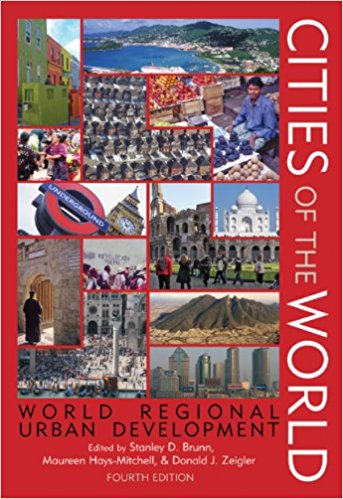|
|
Cities of the World: World Regional Urban Development
Capítulo: Cities of Middle America and the Caribbean
Editores:Stanley D. Brunn, Maureen Hays-Mitchell & Donald J. Ziegler Autores de capítulo: Irma Escamilla, Joseph L. Scarpaci & Adrián Guillermo Aguilar ISBN: 978-0-7425-5597-6 Edición: 4° ed. 2008 Editorial: Rowman & Littlefield Publishers, Inc Cítese como: Escamilla, I., Scarpaci, J., & Aguilar, A. (2008). Cities of Middle America and the Caribbean en S. Brunn, M. Hays-Mitchell y D. Ziegler (Coords), (4th ed), Cities of the world: World Regional Urban Development, (Pp. 103-141), Lanham: Rowman & Littlefield Publishers, Inc. |
|
Key chapter Themes: . 1. The mexican urban system was forged in large measure by the Aztec pattern of urbanization. It was subjugated mitilitarily by the Spanish fo facilitate the colonizers dual mission of proselytizing and mining. 2. It was until the second haldf of the 19th century that new important regional centers emerged, stimulated by foreign investment ande the development of railways and highways. 3. Between 1900 and 1940, the urban population of Mexico grew at a rate far greater than that of the Mexican population in general; most urban growth was concentrated in the larger cities of Mexico. 4. Today, urban growth in Mexico is occuring in intermiadiate cities located close to large cities, in cities along the U.S. - Mexican border, and in independent cities in remote regions far from the large agglomerations. . 5. The urban systems of Central america and the Caribbean developed under various European powers and followed and agricultural- driven model of colonial and post-colonial growth. 6. Today, Central America is nearly 70% urban, ranging form approximately 45% in honduras and Guatemala to 59% and 66% in Costa Rica and Panama, respectively, National poverty rates parallel urbanization rates in that poorest countries are the least urbanized countries. 7. Social and geographic segregation has deepened in Central America's cities; crime and violence are serious problems. 8. Four patterns highlight contemporary urbanization in the Caribbean: urban primacy characterizes every island; the number of cities with 1 to 5 million residents has more thandoubled; mind-sized cities (500,000 to 1,000,000 residents) have declined; and insularity is a key constraint on many islands. 9. Since the mid-20th century, Cuba has taken the most divergent path to urban and national development in the past half-century with its variant form of socialist cities . 10.Natural disasters in the Caribbean, Central America, and Mexico compound the challenges of urban poverty.
|






